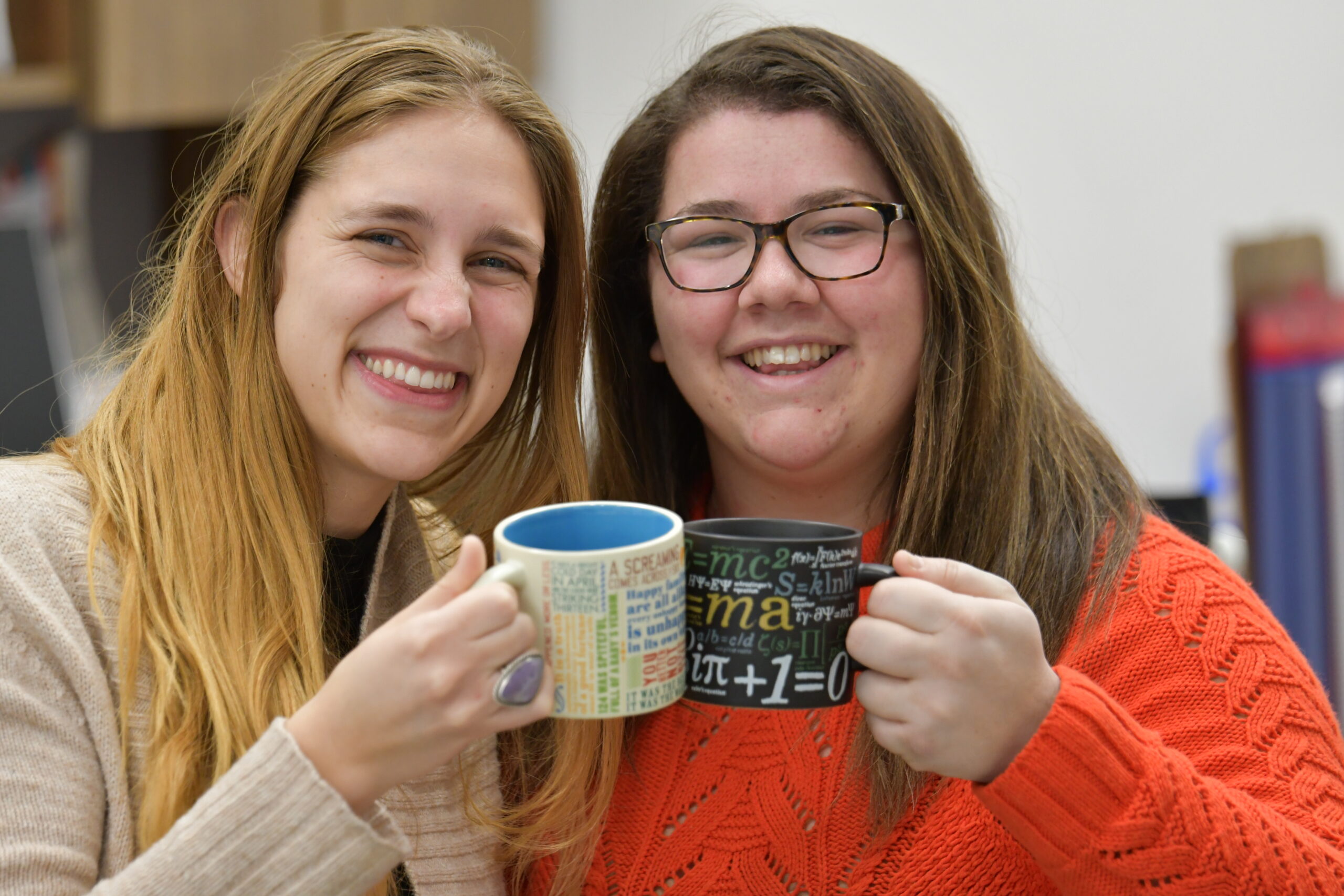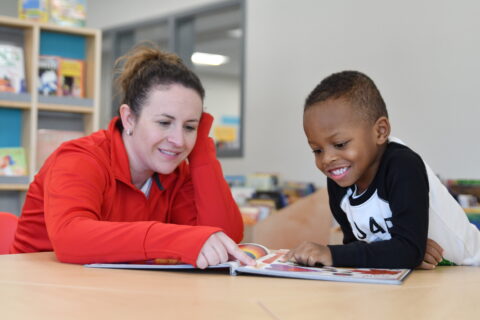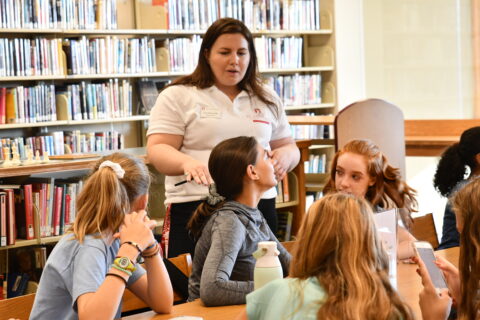By Molly Magner and Julia Dean
Editor’s Note: This article was originally published in Volume 3 of “Think Differently and Deeply” (2018).
Picture this: two colleagues divided by discipline but connected by research; detached by division but united by mission. As members of both the CTTL team and St. Andrew’s faculty, we are often immersed in conversations about research, which we apply in our own math and English classes.
One subject fascinated both of us because of its difficulty to explain in our CTTL work: metacognition. In its simplest form, metacognition means thinking about one’s thinking. Additionally, metacognition can be thought of as using past experiences to navigate a better path through one’s current work. (1)
Honing metacognitive skills empowers students with self-knowledge that they can apply beyond classroom walls. But how can teachers help students gain important but under-appreciated set of skills? What does metacognition in action look like?
Students often enter into both math and English classes with a fixed mindset. (2) We often hear students saying things like: “I’m not a math person” or “I’m not a good writer.” But having students practice identifying their thought processes and which steps they went through to solve a problem or write an essay helps them shift their mindset. Our ultimate goal is to empower students with the ability to use their past as a tool rather than feel defeated by it.
Build a Culture of Questioning
“You shouldn’t take Tylenol before you have a headache.” This line, often said by a fellow SAES math teacher, has changed how I plan my classes. As a student, I felt I was taught a skill like solving proportions and then given time to practice the skill, never fully understanding what a proportion was or why I was solving it in this way. This focus on surface level algorithms rather than deep understanding stops students’ desire to think and grow since the thinking has already been done for them. They leave knowing how to solve that problem but not understanding or appreciating the concepts that would allow them to solve marginally related problems.
My approach now is to help them use prior knowledge in a new context by beginning class with an open-ended question. I choose questions that are somewhat related to what they already know but which, particularly at first glance, feel totally new. This allows students the time needed to access their “toolbox” and think metacognitively about which problem-solving strategies to employ rather than being given the tool they will need to solve each problem.
These problems can be incredibly frustrating but eventually rewarding for students. To support them in this endeavor, students are required to ask questions, which eliminates the, “Ms. Magner, I don’t get this!” Encouraging students to ask questions forces them to think about their own thinking. The best part about this rule is that most of the time simply creating the question is enough to get them started on the problem themselves!
I used to think students needed to be explicitly taught how to apply their existing skills and knowledge into a new context. But now I know that students benefit more from being active participants when learning how to apply existing knowledge into a new context, and that it is my job to pick a new context that is not too hard and not too easy so they have productive struggle. (3)
Model It Ourselves: Think Aloud
In English, often I assign reading/annotating for homework. But I have realized that reading during class is an opportunity to model metacognition. Reading aloud in class, pausing periodically to ask students questions about the plot and literary terms, is a way to model active reading. I encourage my students to ask their own questions as we read, emphasizing the importance of actively, critically engaging with the text— using their previous experiences to help them navigate through their current thinking which is at the heart of metacognition. I have noticed that when I model for my students in this way, they are more engaged and eager to add their own opinions, questions, and theories as to what will happen next. During these read alouds, students can more clearly appreciate the complexity of the thinking process during active reading.
I used to think that students should intuitively know how to annotate. But now I know that modeling helps students understand what it means to actively read.
In math class, my students love volunteering to solve problems on the whiteboard, but I noticed that students have a hard time explaining their thinking, which indicates they are having a hard time thinking about their own thinking. During the first few weeks of school, I model my own problem-solving process a lot. I explain each step of solving a multi-step equation, sharing why I chose to subtract 2 before I divided each side by 3, for example. I also mention the numerous ways I could have approached a problem and justify to the class why I ultimately chose one way over the other. When students go to the board to do a problem, the expectation is that they also talk out each step and why they chose it. I continue to verbalize my own problem-solving process throughout the year to help build a classroom culture where thinking about our own thinking is the norm.
I used to think that students needed more time to practice problems on their own, but now I know that while this is still true, it is helped by my modeling the problem solving process to the whole class.
Listen to Molly and Julia talk about incorporating metacognition into their classes in Episode 11 of the Think Differently and Deeply Podcast, recorded in 2019.
Move Beyond Reflection: Precision is Key
Both teachers and students confuse metacognition and reflection; metacognition stems from reflection, but not all reflection leads to metacognition. In his book How We Think, educational philosopher John Dewey thinks of metacognition as a type of reflection about one’s own way of thinking. (4) As teachers, we ask students to reflect on many things, but if we want students to work actively on building their metacognitive skills, we need to take them on a reflective journey which leads them to analyze their own thinking processes. This goes significantly beyond asking them how well they think they did on a test.
In English class, I explicitly taught my students three strategies for memorizing vocabulary: self-testing, revisiting the words in context, and visualizing their vocabulary. I then handed back to the students their last vocabulary quiz and asked them to write about how they prepared for the quiz, how that study method worked or didn’t work, and which of the three new strategies they would employ for the next quiz.
I later had an honest conversation with one of my students who, after failing the quiz, asked me for additional help. He admitted that he had studied by himself during the early morning hours the day of the quiz. We discussed how he could leverage his verbal expressive skills to learn vocabulary through conversation, one of his favorite pastimes. Through this process, together we walked the metacognitive walk, thinking about how he approached the problem before, what didn’t work, and what usually does work when he’s processing ideas: talking.
I used to think post assessment free form reflection was enough to improve learning. But now I know that structured opportunities for students to think about their own thinking are more effective.
In math class, there is this phenomena of “silly mistakes.” What I have learned in my time teaching middle school math is that anything can be labeled a silly mistake, including: adding two numbers incorrectly, not distributing the negative, not following order of operations; the list goes on and on. I avoid using over-simplistic labels like “silly mistake.” Instead, I emphasize the power of mistakes because of how much we can learn from them.
After each assessment, students do an error analysis of any mistakes they made. I noticed that unless students fully understand the mistakes they made, they won’t learn anything from them. Calling mistakes “silly” or “careless” takes the ownership away from the students. Instead of using these terms, I provide students with more precise observations of their mistakes to ensure they fully understand what went wrong so that they do not make the same mistake again. Students then have to reflect back on their thinking and their problem solving process to see where they went wrong. For example, adding 7+2 and getting 8 isn’t simply a “silly” mistake to make; instead, it is a computation error and means that students need to check their work as they solve problems.
I used to think having students do quiz corrections was enough. But now I know that precision of language is necessary for students to truly learn from their mistakes.
Practice What You Preach
Students shouldn’t be the only ones practicing metacognition. Ask yourself the following questions to expand your own metacognitive skills: why did I structure my lesson in that particular way? What would I like to learn how to do better? What am I confused about?
One simple way to put this into practice: immediately after class, write in your lesson plan a short note about what went well, what didn’t go well, and what you’d like to do next time as a guide for your next lesson.
In addition, you may have noticed that after each section we added a “I used to think… but now I think” statement. (5) This is a simple way to capture how your thinking has changed: try using it yourself and with your students!
We used to think that math and English teachers couldn’t learn from each other. But now we know metacognition is applicable across disciplines!
Molly Magner (@molmags) is the Assistant Dean of Middle School and teaches Middle School Math. Julia Dean is a former Upper School English teacher and was the CTTL’s Program Development and Innovation Associate. Both are certified TAKOM facilitators.
Citations
1) “Meta-Cognition and Self-Regulation | Toolkit Strand | Education Endowment Foundation | EEF.” (https://educationendowmentfoundation.org.uk/evidence-summaries/teaching-learning-toolkit/metacognition-and-self-regulation).
2) “Book Study: Mindset, The New Psychology of Success by Carol Dweck.” (http://www.childstudysystem.com/uploads/6/1/9/1/6191025/mindset_book_study.pdf).
3) This “I used to think but now I think (know)” is adapted from the Visible Thinking Routines designed by Ron Ritchhart as part of Project Zero at Harvard University’s Graduate School of Education.
4) John Dewey. How We Think (Cosimo, 2008).
5) “Visible Thinking.” (https://pz.harvard.edu/resources/i-used-to-think-now-i-think).




